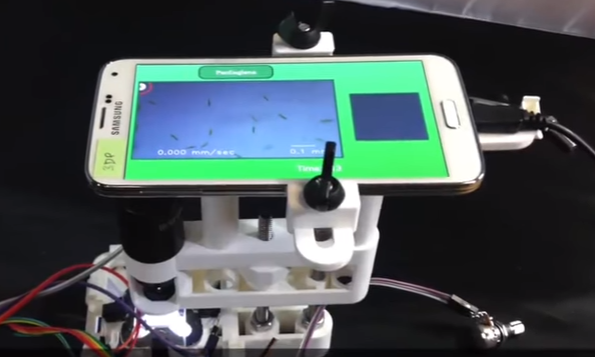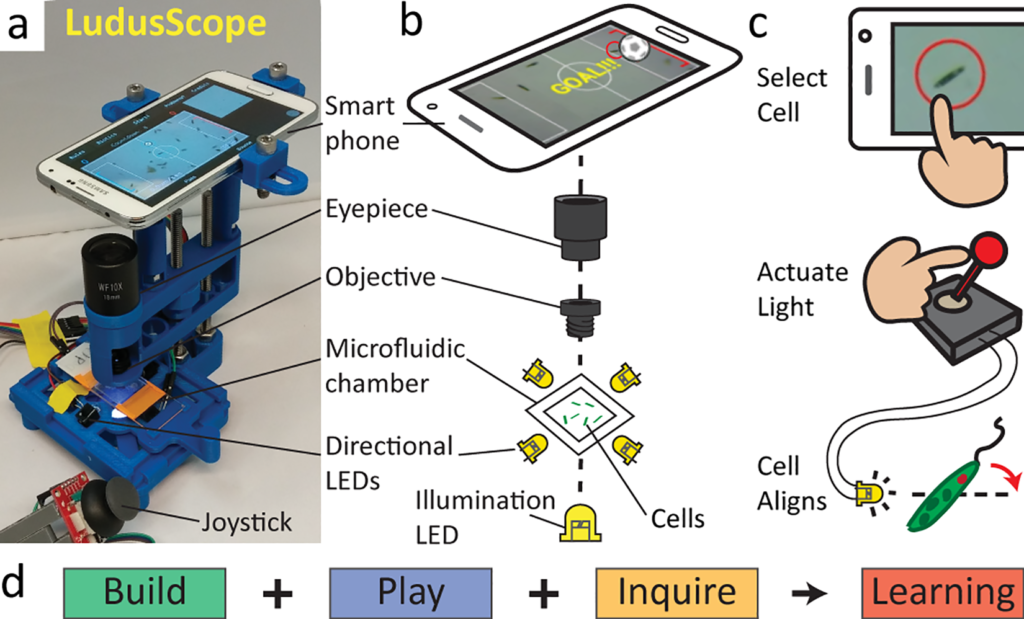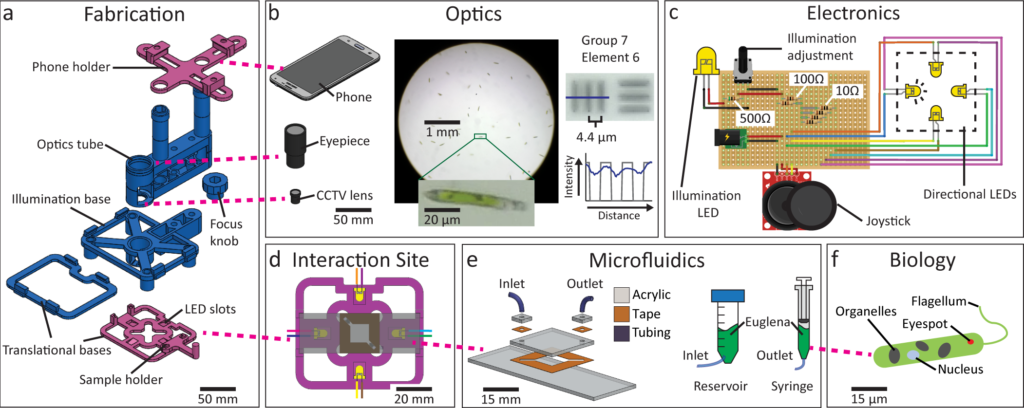Get Your Kids Excited About Microbiology Now with the 3D Printed Microscope Powered by Your Smartphone
 Parents love to discuss what their kids are ‘into,’ and this came up recently as my daughter was going to a birthday party for a boy in her class and we had no idea what to give him. This precipitated a call only to discover that he was into the predictable Harry Potter/Star Wars theme, making shopping fairly easy after all. The week before we shopped for another classmate, a girl, who is into ballet and everything pink. Now, I think it would be amusing all around to give my kids a new smartphone gaming device emerging from Stanford University, watch them go—and when someone calls around birthday time next month to ask what my daughter is into, I’ll just casually say, “Oh, you know—Euglena, microbiology—that kinda stuff.”
Parents love to discuss what their kids are ‘into,’ and this came up recently as my daughter was going to a birthday party for a boy in her class and we had no idea what to give him. This precipitated a call only to discover that he was into the predictable Harry Potter/Star Wars theme, making shopping fairly easy after all. The week before we shopped for another classmate, a girl, who is into ballet and everything pink. Now, I think it would be amusing all around to give my kids a new smartphone gaming device emerging from Stanford University, watch them go—and when someone calls around birthday time next month to ask what my daughter is into, I’ll just casually say, “Oh, you know—Euglena, microbiology—that kinda stuff.”
Developed by Ingmar Riedel-Kruse, an assistant professor of bioengineering at Stanford, the innovative 3D printed microscope which is powered by your smartphone is meant to engage the younger set with fun and learning at their level, using technology they are certainly familiar with today, and encouraging an introductory interest in microbiology.
“Many subject areas like engineering or programming have neat toys that get kids into it, but microbiology does not have that to the same degree. The initial idea for this project was to play games with living cells on your phone. And then it developed much beyond that to enable self-driven inquiry, measurement and building your own instrument,” said Riedel-Kruse.
Dubbed the LudusScope by Riedel-Kruse, the device was inspired by the Latin word for ‘play’ or ‘game.’ The 3D printed parts are easily assembled, offering a platform for slides where children can see Euglena microbes swimming. Equipped with a joystick that causes the LEDs to light up responsively, the LudusScope draws the children in as they realize they can manipulate the swimming direction of the microbes.
There are multiple games to play on the LudusScope, and children are able to enjoy a wide range of software choices to run as an overlay on top of the cells. From one game that is reminiscent of Pac-Man and even featuring a maze of white dots to another that is similar to soccer with kids trying to send the Euglena through the goals, kids are enjoying themselves while also getting involved in science. There are also applications for the LudusScope that offer a straight microbiology angle without gaming, to include microscope scale-bars, swimming speed of the cells in real time, along with zooming in on cells individually. All of this means that kids can learn about Euglena as they collect data.
The project came about as Riedel-Kruse was offering more advanced form of the microscope for his university students.
“We wondered if we could make it so easy to replicate that even middle-schoolers could build it,” he said.
The more elementary design is obviously the perfect project for a classroom, allowing for 3D printing numerous parts of the microscope and then wiring the joystick controller circuits. The Euglenia cells can be ordered easily and are found being studied in many classrooms. Students would undoubtedly find it cool to ‘game’ with Euglena swimming in a chamber they created by using the slide, double-sided tape, and a cover slip.
The engineer behind all of this states that he sees the exercises of building, observing, interacting, and modeling the cells to fit in easily within the Next Generation Science Standards so many schools are currently focused on. His project is outlined in the paper, ‘LudusScope: Accessible Interactive Smartphone Microscopy for Life-Science Education,’ also authored by Honesty Kim, Lukas Cyrill Gerber, Daniel Chiu, Seung Ah Lee, Nate J. Cira and Sherwin Yuyang Xia.
“The NGSS are now introduced to US K-12 education and particularly emphasizes the need for new and cross-disciplinary educational approaches, active learning approaches and teaching critical thinking,” state the researchers in their paper. “We therefore set out to develop an accessible cross-disciplinary biology platform that utilizes smartphone microscopy to enable open-ended interaction and exploration with microorganisms.”
“We designed the LudusScope for easy replication and we developed smartphone applications for both serious science and playful games, thereby incorporating building, playing, and inquiring as three major modalities for science, technology, engineering, and math (STEM) learning.”

(A) Smartphone displays interactive biology application. (B) The optics of the LudusScope mimics a traditional microscope, but four additional LEDs allow stimulation of motile microorganisms, e.g., Euglena gracilis. (C) The user can interact with individual cells by digitally selecting them via touch screen, and then operate a joystick to actuate the four directional LEDs, which then provide light stimuli to induce phototactic responses, e.g., the cell’s swimming direction aligns with the light. (D) The LudusScope integrates three essential educational modalities: Build, play, and inquire. (From ‘LudusScope: Accessible Interactive Smartphone Microscopy for Life-Science Education’)
And while teachers he shared his new 3D printable device with definitely saw the educational value, Riedel-Kruse said they may not all have caught on so much to the gaming aspect and its benefits.
“I thought the interactive cell stimulation and the resulting games was the coolest thing but the teachers and students didn’t necessarily agree,” Riedel-Kruse said. “What they were more excited about is the more basic things like the ability to build your own instrument, that multiple people can see the screen at the same time and that you can select and track individual cells.”
A seed grant is helping propel his work forward too as he works with an educational game company. They will be testing the product with users further, as well as creating a science kit that could be released in over a year or so. Discuss further in the 3D Printed LudosScope forum over at 3DPB.com.
[Source: Stanford News]Subscribe to Our Email Newsletter
Stay up-to-date on all the latest news from the 3D printing industry and receive information and offers from third party vendors.
You May Also Like
Gorilla Sports GE’s First 3D Printed Titanium Cast
How do you help a gorilla with a broken arm? Sounds like the start of a bad joke a zookeeper might tell, but it’s an actual dilemma recently faced by...
Nylon 3D Printed Parts Made More Functional with Coatings & Colors
Parts 3D printed from polyamide (PA, Nylon) 12 using powder bed fusion (PBF) are a mainstay in the additive manufacturing (AM) industry. While post-finishing processes have improved the porosity of...
$25M to Back Sintavia’s Largest Expansion of Metal 3D Printing Capacity Since 2019
Sintavia, the digital manufacturing company specializing in mission-critical parts for strategic sectors, announced a $25 million investment to increase its production capacity, the largest expansion to its operations since 2019....
Velo3D Initiates Public Offering in a Bid to Strengthen Financial Foundations and Drive Future Growth
Velo3D (NYSE: VLD) has been among a number of publicly traded 3D printing firms that have attempted to weather the current macroeconomic climate. After posting a challenging financial report for 2023,...
































